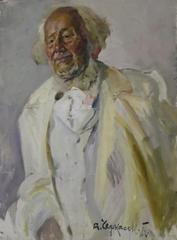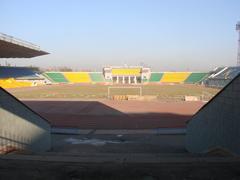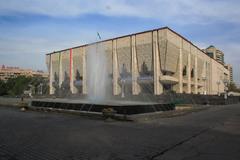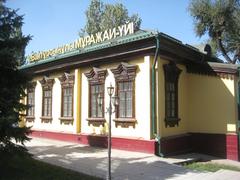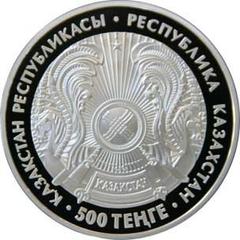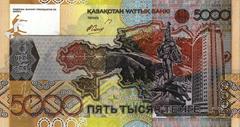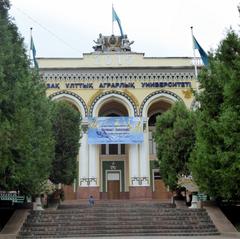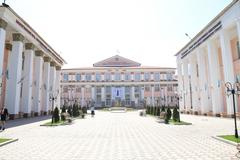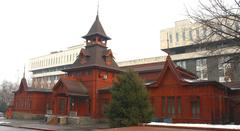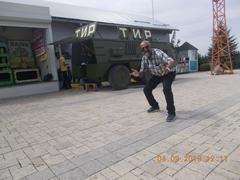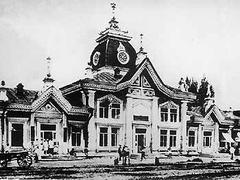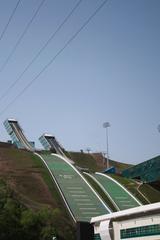Verny Fortress Almaty Kazakhstan: Visiting Hours, Tickets, and Historical Sites Guide
Date: 04/07/2025
Introduction
Verny Fortress, nestled in the heart of Almaty, Kazakhstan’s largest city, stands as a pivotal emblem of the city’s transformation—from a 19th-century Russian military outpost to a dynamic urban and cultural center. Established in 1854 during the Russian Empire’s expansion into Central Asia, Verny Fortress not only secured strategic territory but also catalyzed the growth of modern Almaty. Today, while the original fortress no longer stands, its legacy endures in the city’s urban fabric, historic landmarks, and vibrant multicultural identity. This comprehensive guide explores Verny Fortress’s historical significance, provides practical visiting information, and highlights the best ways to experience Almaty’s unique heritage (Caravanistan, tmatic.travel, Vamados).
Table of Contents
- Early Settlement and Silk Road Legacy
- Russian Imperial Expansion and the Founding of Verny Fortress
- Urban Growth, Earthquakes, and Reconstruction
- Soviet Transformation and Contemporary Almaty
- Verny Fortress Today: Remnants and Visitor Experience
- Architectural and Cultural Significance
- Practical Visitor Tips
- Frequently Asked Questions (FAQ)
- Conclusion: Embracing Verny Fortress’s Legacy
- Sources and Further Reading
Early Settlement and Silk Road Legacy
The region around present-day Almaty has been inhabited for millennia, with archaeological discoveries revealing Scythian burial mounds and ancient settlements. By the 10th century, a Silk Road settlement named Almatu flourished here, serving as a vital trading hub between East and West. However, consecutive Mongol and Dzhungar invasions led to repeated destruction, and the area remained a modest frontier until the 19th century (Caravanistan).
Russian Imperial Expansion and the Founding of Verny Fortress
Seeking to consolidate its hold over Central Asia, the Russian Empire established the Zailiysky Fort in 1854 near the remnants of Almatu. Soon renamed Verny (“Loyal”), the fortress was constructed by Cossack troops under Major M.D. Peremyshlsky and designed with input from European military engineer Eduard Totleben. Its pentagonal layout, earthen ramparts, and wooden palisades exemplified advanced 19th-century fortification techniques (tmatic.travel).
Verny rapidly grew into a multicultural settlement, attracting Russians, Cossacks, Kazakhs, Tatars, and Uyghurs. By the late 1800s, it had become an administrative and cultural hub, with the 1868 urban plan (by Krishtanovsky and Zenkov) laying the foundation for modern Almaty (Vamados).
Urban Growth, Earthquakes, and Reconstruction
The city’s growth accelerated with the construction of the Turkestan-Siberian Railway in the early 20th century (Mexico Historico). Verny’s multicultural character was reflected in its religious institutions and architectural diversity. However, the 1887 earthquake devastated much of the city, prompting a shift to earthquake-resistant wooden architecture.
The Ascension Cathedral (Zenkov Cathedral), completed in 1907 and designed by Andrei Zenkov, stands as a testament to seismic innovation. Built entirely of wood without nails and standing 54 meters tall, it remains one of the world’s tallest wooden buildings, renowned for its resilience and beauty (pck.kz).
Soviet Transformation and Contemporary Almaty
In 1921, Verny was renamed Alma-Ata. The Soviet era brought rapid industrialization, monumental architecture, and the city’s designation as the capital of Soviet Kazakhstan. New boulevards, public buildings, and green spaces transformed the urban landscape, blending functionalism with local motifs (KoreaScience).
Post-independence, Almaty experienced revitalization, with restored heritage sites, modern infrastructure, and an emphasis on green, walkable neighborhoods. Although the capital moved to Astana (now Nur-Sultan) in 1997, Almaty remains Kazakhstan’s cultural and economic heart (Caravanistan).
Verny Fortress Today: Remnants and Visitor Experience
Physical Footprint and Commemoration
The original Verny Fortress structures have not survived, but its historical footprint is preserved in central Almaty’s street grid, the location of Panfilov Park, and surviving architectural monuments. Commemorative plaques and museum exhibits highlight the fortress’s boundaries and historical significance (KoreaScience).
Key Landmarks
- Panfilov Park: Once the Governor’s Garden, this lush park is built on the former fortress grounds and is home to the Ascension Cathedral, the Folk Instruments Museum, and World War II memorials (Astana CityPass).
- Ascension Cathedral (Zenkov Cathedral): A masterpiece of seismic engineering and neo-Russian architecture, renowned for its vibrant colors and ornate woodwork (pck.kz).
- Military History Museum: Showcases the military and urban history of the region, including the story of Verny Fortress.
Visiting Hours and Tickets
- Panfilov Park: Open 24/7, free entry.
- Ascension Cathedral: Open daily 10:00 AM–6:00 PM (closed Mondays and during services), free entry (donations appreciated).
- Folk Instruments and Military History Museums: Typically open 10:00 AM–6:00 PM, with a nominal ticket fee (300–1000 KZT; check on-site for details).
Guided walking tours and audio guides are available through local operators and visitor centers (tmatic.travel).
How to Get There
- Metro: Almaty’s metro is convenient and affordable. Stations Almaly and Zhibek Zholy are closest to Panfilov Park and the former fortress area (Explore Travel Oasis).
- Buses and Taxis: Major avenues like Dostyk and Abai are served by buses, trolleybuses, and ride-hailing apps.
- By Foot or Bicycle: The historical center is compact and walkable, with pedestrian streets and bike rentals available (Explore Travel Oasis).
Special Events and Tours
Panfilov Park and the fortress area regularly host national celebrations, cultural festivals, and guided tours, especially during spring and autumn. Booking ahead is recommended during peak seasons (Travelspilot).
Architectural and Cultural Significance
Verny Fortress’s legacy endures in Almaty’s cityscape, from its grid layout to its multicultural religious and civic buildings. The wooden architecture—especially the Ascension Cathedral—reflects both Russian imperial influences and local earthquake engineering. The area’s neo-Russian and vernacular styles are visible in landmarks like the Kyzyl-Tan building and Zenkov Cathedral (en.wikipedia.org).
The fortress area was always a cultural melting pot, hosting Russians, Kazakhs, Uzbeks, Tatars, and others. Multicultural coexistence is still evident in the city’s religious, educational, and public spaces (Qalam Global).
Practical Visitor Tips
- Best Time to Visit: Late spring to early autumn for pleasant weather.
- Dress Code: Modest attire is recommended for religious sites.
- Language: Kazakh and Russian are spoken; English is common in tourist areas.
- Accessibility: Most major sites are wheelchair accessible, though some historic buildings may pose challenges.
- Nearby Attractions: Central State Museum, Green Bazaar, Arbat Street, Kok-Tobe Hill.
- Photography: Allowed in outdoor areas; restricted inside religious sites during services.
Frequently Asked Questions (FAQ)
Q: What are Verny Fortress visiting hours?
A: Panfilov Park is open 24/7. Ascension Cathedral is open 10:00 AM–6:00 PM, closed Mondays.
Q: Do I need to buy tickets?
A: Park entry is free. Museums and cathedrals charge a small fee (or accept donations).
Q: Are guided tours available?
A: Yes, local operators offer historical walking tours; advance booking is advised.
Q: How accessible is the site?
A: The park and main landmarks are accessible; some older buildings may have limited access.
Q: What’s the best way to get there?
A: By metro (Almaly, Zhibek Zholy), bus, taxi, or on foot from the city center.
Conclusion: Embracing Verny Fortress’s Legacy
Verny Fortress is more than a vanished military structure; it is the cornerstone of Almaty’s identity, reflected in its urban plan, surviving monuments, and living traditions. Exploring the fortress area—especially Panfilov Park, Ascension Cathedral, and the surrounding historic streets—offers unique insight into Kazakhstan’s layered past and vibrant present.
Whether you are a history enthusiast, architecture lover, or casual traveler, a visit to Verny Fortress’s legacy will deepen your understanding of Almaty’s evolution and enduring spirit. For up-to-date information, guided tour options, and travel tips, download the Audiala app and follow us on social media for the latest on Almaty’s historical and cultural sites.
Sources and Further Reading
- Caravanistan: Exploring Verny Fortress in Almaty
- tmatic.travel: Verny Fortress Visiting Hours, Tickets & Historical Significance
- Central Asia Travel: Verny Fortress Historical Guide
- Vamados: Almaty Travel Guide
- Architecture of Almaty – Wikipedia
- Ascension Cathedral – pck.kz
- Mexico Historico: Evolution of Almaty’s Urban Landscape
- Astana Times: Verny and Alma-Ata
- Urbani Izziv: Verny Fortress Urban Study
- OrexCA: Guide to Verny Fortress and Almaty Historical Sites
- Sid the Wanderer: Almaty Travel Guide
- Walking Almaty: Historic Maps and Sites
- Qalam Global: Almaty Heritage and Identity
